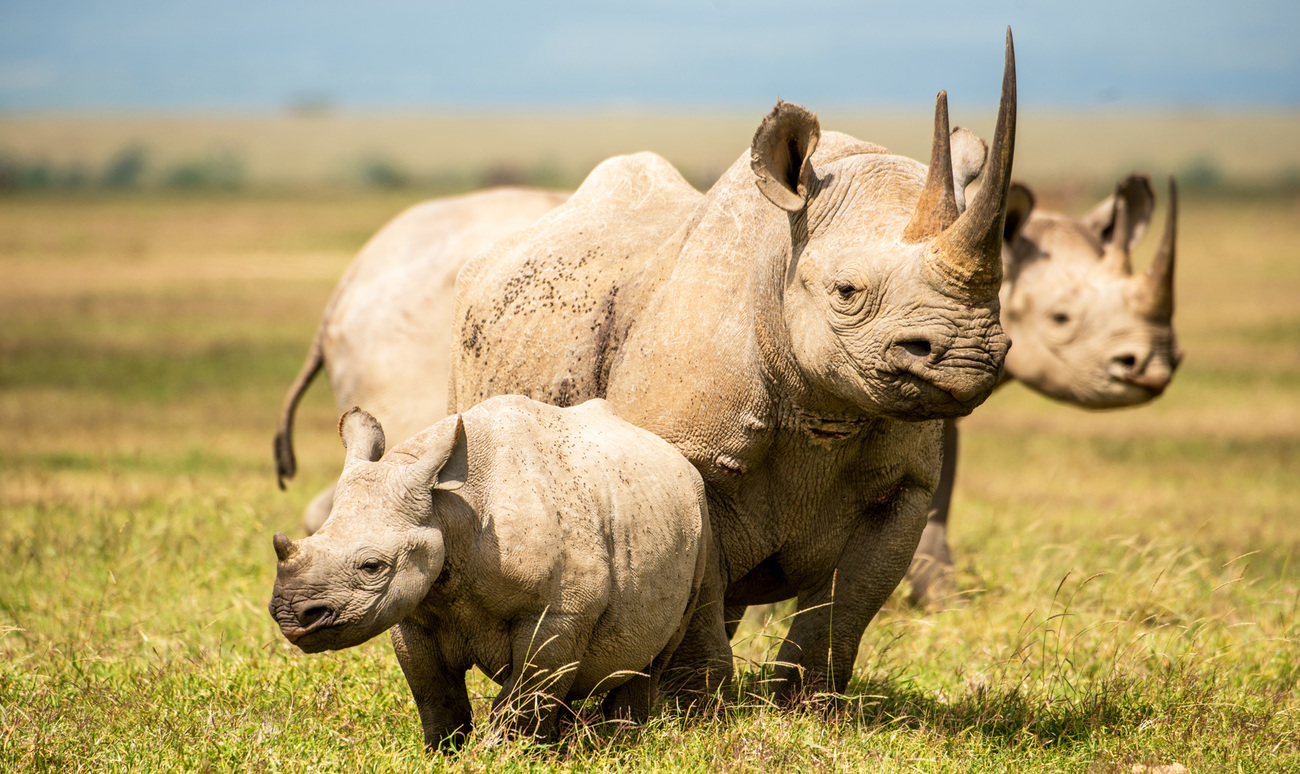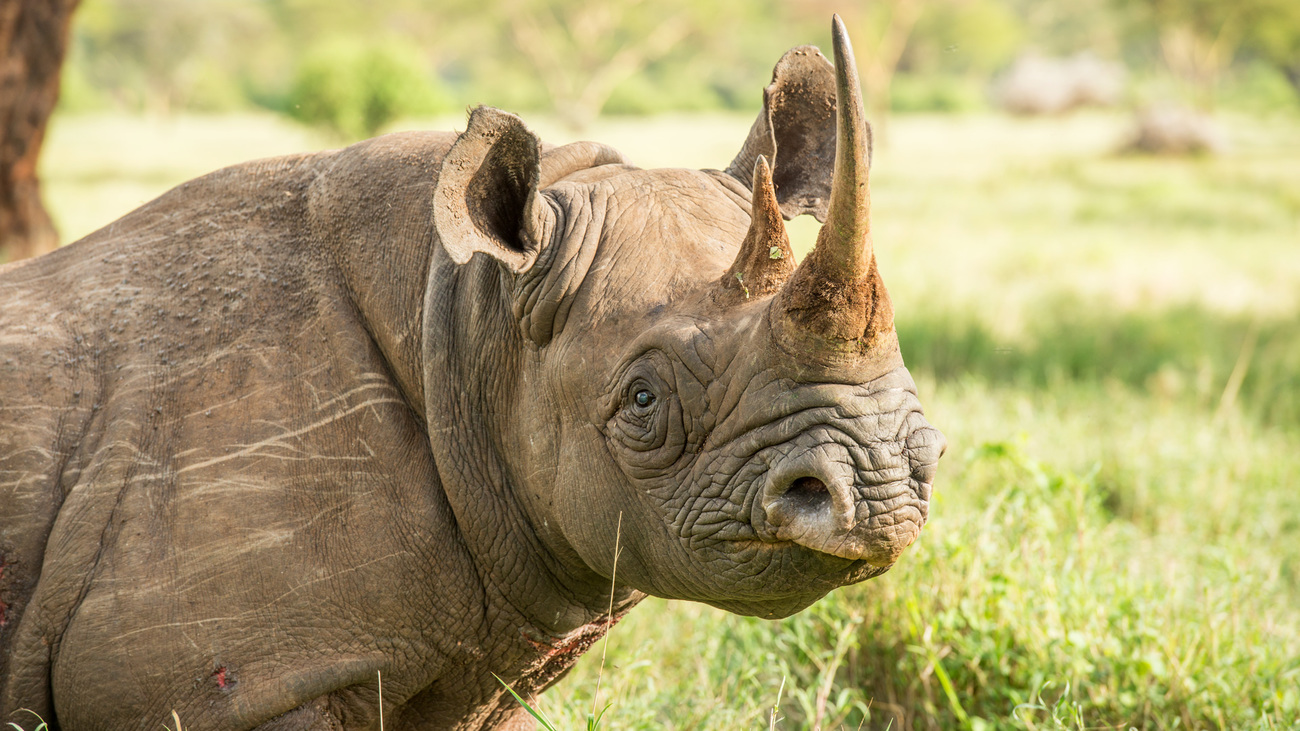Centre for Wildlife Rehabilitation and Conservation - India
Near Kaziranga National Park, animals are being threatened by a single highwayblack rhinos vs. greater one-horned rhinos: what’s the difference?
black rhinos vs. greater one-horned rhinos: what’s the difference?

Written by Lara Jackson, conservation biologist
Rhinos are arguably one of the most iconic mammals in the animal kingdom, and they’ve captured the hearts of wildlife lovers around the world, including me. As a conservation biologist, I have spent months in Kenya following the feeding pathway of black rhinos to research and better understand their dietary preferences.
Though I’ve spent most of my career studying the black rhino, I recently had the opportunity to observe the greater one-horned rhino. On a visit to India, I met two greater one-horned rhino calves in the care of expert keepers at the IFAW and Wildlife Trust India Centre for Wildlife Rehabilitation and Conservation (IFAW-WTI CWRC), who plan to release them back into the wild.
Aside from living on different continents, there are several differences between the greater one-horned rhino and the black rhino.
horns
The horn is the most recognisable feature for all rhino species, and it is the most obvious difference between greater one-horned rhinos and black rhinos. Black rhinos have two horns, whereas the greater one-horned rhino, as the name suggests, has only one horn.
Rhinos use their horns for a variety of reasons. Black rhinos use their horns for self-defence if attacked by a predator and to fight other males to establish dominance during the mating season. They also use their horns for communication, social interactions with other rhinos, and to mark their territories by gouging marks into trees and the ground.
Greater one-horned rhinos also use their horns for defence, but unlike black rhinos, they do not use their horn for fighting. During a fight, males will instead use their long lower incisor teeth (which can grow up to eight centimetres long) to inflict deep wounds. They also use their horns to search for food and to forage for fresh, tasty roots.

size
Black rhinos are much smaller than greater one-horned rhinos, weighing (on average) between 800-1,400 kilograms and reaching 1.5-1.75 metres at the shoulder.
Greater one-horned rhinos are the second largest of the rhino species, smaller only than the African white rhino. They weigh between 1,600-2,700 kilograms, almost double the weight of a black rhino, and they reach 1.8-2.0 metres at the shoulder.
appearance
Both greater one-horned and black rhinos have grey skin that is very tough and thick. However, greater one-horned rhinos have distinctive armour-like plates that cover their bodies. Although they look formidable, the plates are just thick folds of skin with more flexible segments of skin in between that allow the plates to shift as the rhino moves.
what they eat
Black rhinos are browsers, meaning they eat a variety of woody vegetation, shrubs, and shoots, but they do not eat grass. They have a pointed, prehensile upper lip, meaning they have full control over its movements and can use it to grasp twigs and branches. Black rhinos have evolved a smaller head that is easier to lift and support, since they eat from bushes and trees up to two metres tall.
Like black rhinos, greater one-horned rhinos have a prehensile upper lip that they use for foraging, but their diet is much more diverse. They feed on a wide variety of plants including grass, fruits, leaves, tree and shrub branches, agricultural crops, and even submerged or floating aquatic plants. In fact, greater one-horned rhinos love swimming and have been observed diving for their dinner.
where they live
Black rhinos were once widespread across sub-Saharan Africa, but due to a combination of factors, including poaching and habitat loss, their numbers decreased by 96% between 1970 and 1992. There are approximately 6,000 individuals left in the wild. They are now found in small areas of Kenya, Tanzania, Namibia, South Africa, and Zimbabwe.
Black rhinos can live in a range of habitats, including semi-desert savannahs (in Namibia, for example), woodlands, forests, and wetland areas, provided there’s enough woody vegetation. When exploring a new territory, black rhinos will look for a water source and mineral licks within an 8-16-kilometre radius.
The greater one-horned rhino has unfortunately endured similar hardships to the black rhino. Due to habitat loss, human-wildlife conflict, and poaching, the greater one-horned rhino was almost hunted to extinction in the nineteenth century. Thanks to intensive conservation efforts, their numbers are recovering and currently sit at approximately 4,000. Their distribution is limited to India and Nepal, with populations concentrated in Kaziranga National Park and across the foothills of the Himalayas.
Greater one-horned rhinos are semi-aquatic and reside in swamps, forests, wetlands, riversides, marshes, and floodplains.

threats
Despite the incredible conservation efforts that have bought these two species back from the brink of extinction—and despite living two continents apart—these rhinos face similar predicaments.
First, both species are targets for poachers because their horns are used in traditional medicine and, more recently, as ceremonial dagger handles in countries like Vietnam. Unfortunately, the demand for rhino horn has never significantly decreased.
Second, they are both at risk of population decline because of diminishing habitats. As human settlements continue to expand, their last remaining areas of true wilderness shrink.
Third, there is an increased risk of human-wildlife conflict. The greater one-horned rhino generally lives in areas with fertile soils, such as the floodplains surrounding the Brahmaputra River, which increases chances of conflict with humans.
Lastly, these rhinos face a threat that many seem to forget about: climate change. The impact of climate change is already felt in numerous ecosystems around the world. Lewa Wildlife Conservancy in Kenya, for example, has experienced huge vegetation changes across its landscape. Over the last 30 years, 15% of their wooded areas have converted into grassland due to changes in rainfall patterns caused by climate change. This drastic loss of food resources puts the entire black rhino population at risk.
Similarly, the greater one-horned rhinos that live in Kaziranga National Park on the floodplains of the Brahmaputra are experiencing unusual flooding events. The team at CWRC has noticed that the river’s flooding is no longer predictable and is also getting more extreme. This has displaced thousands of rhinos and risks more calves being separated from their mothers. The CWRC has a hugely successful rehabilitation and reintroduction rate for these orphaned rhino calves, but ideally, we wouldn’t have to intervene in the first place.
Related content
Every problem has a solution, every solution needs support.
The problems we face are urgent, complicated, and resistant to change. Real solutions demand creativity, hard work and involvement from people like you.